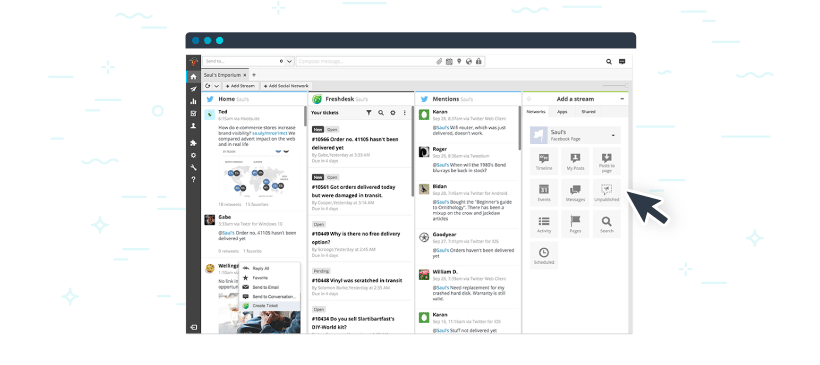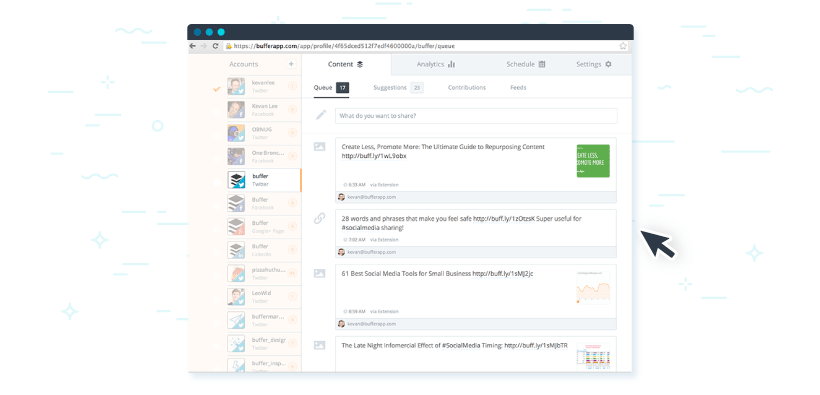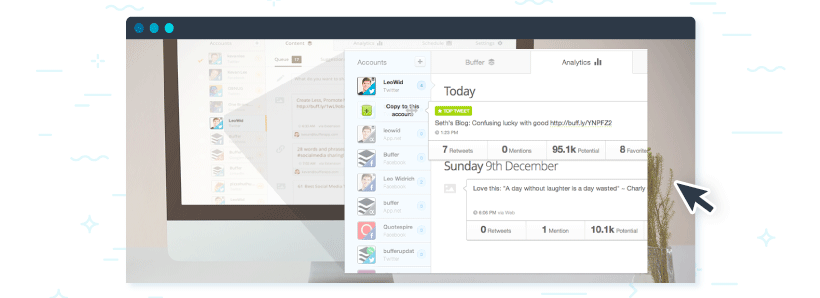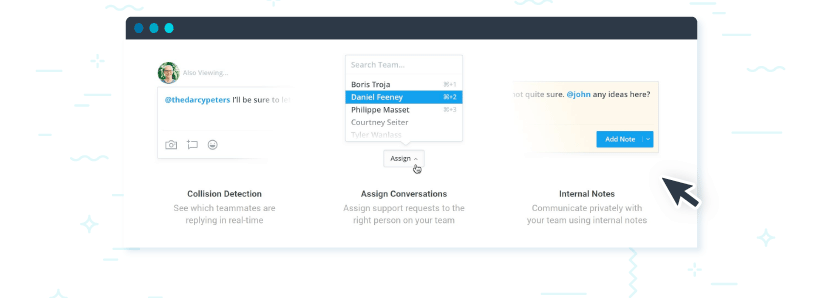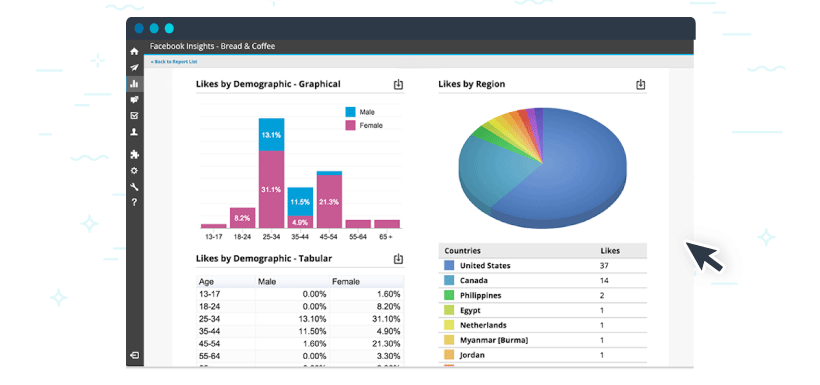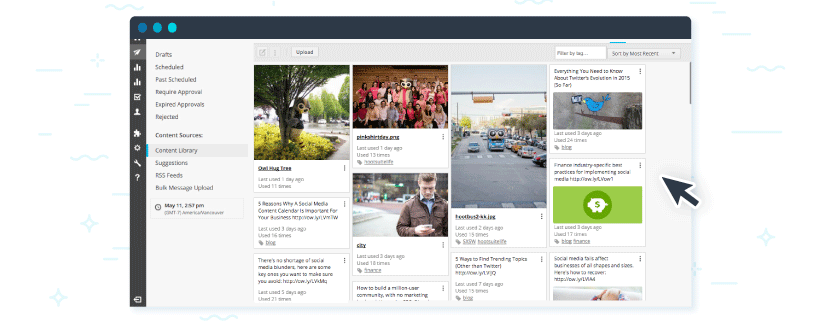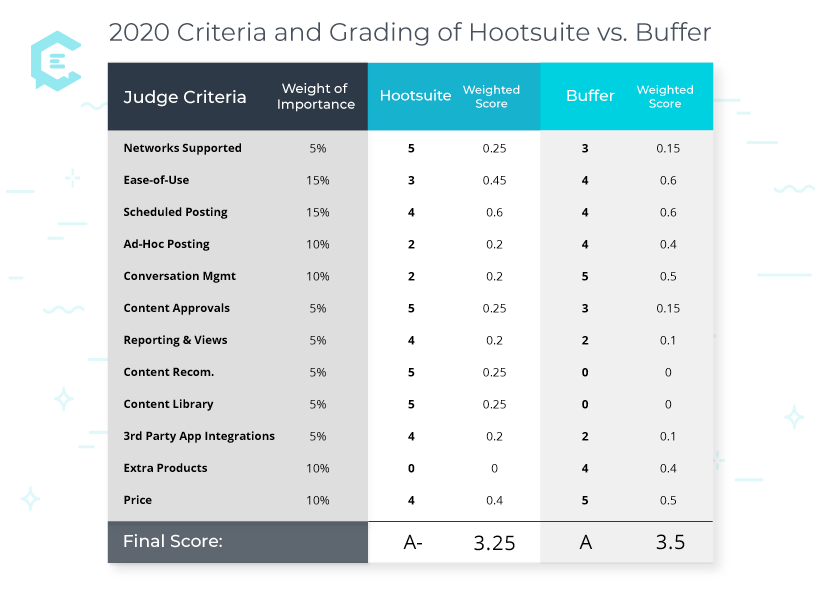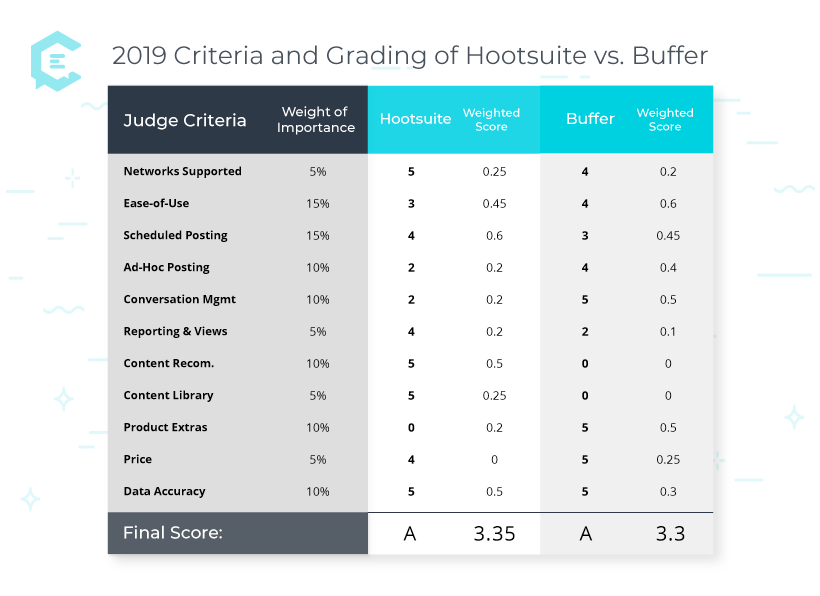Not only is social media a high priority for internal marketers, but it has also become a priority for agencies, marketing freelancers, and independent consultants.
In fact, according to a study at ClearVoice, 80 percent of expert freelancers create social media content for their clients.
Social media itself is a living organism — growing, changing, and evolving all the time. In 2019 alone, we’ve seen many changes to today’s top social media platforms, including Instagram, Pinterest, Facebook, YouTube, Snapchat, TikTok, and many others.
That’s why we’ve refreshed this article, which was originally published in March of 2017. For this week’s #MartechMonday article, we’ve taken another close look at Hootsuite versus Buffer.
Summary of Hootsuite and Buffer
Hootsuite and Buffer continue to lead the market as top social media management tools. We have used both Hootsuite and Buffer extensively, and have neither affiliate nor other direct ties to either of these companies. Both continue to be excellent solutions for small- and medium-sized businesses, agencies and freelancers; however, in our opinion, they appeal to different audiences.
In this article, we’ve included a summarized review of both Hootsuite and Buffer, and also included the grading for each criterion. We’ve also included the original grading rubric from March 2017, when we first published this article, pre-refresh, so you can see how these tools have evolved over the years.
Hootsuite
Initial impressions
The process and experience of logging in and setting up a Hootsuite account have come a long way. When we first published this article, the process and experience reminded us of a Microsoft-made product circa Windows 10. Today, the user interface is much more intuitive, easy to navigate, and user-friendly — a significant improvement from 2017. With the addition of the large, green “New Post” button at the top right of the screen, it is much easier to create and schedule new posts.
Main strength
Hootsuite is powerful and has added considerable functionality, including team management and collaboration functions, content approvals, and the ability to integrate with other third-party apps and tools.
Hootsuite does continue to offer its free plan, but functionality is limited. To really see the most from Hootsuite, most users need a paid subscription. The Pro subscription starts at $29/month and it includes up to 10 social media profiles, unlimited scheduling, and one user. For larger teams, Hootsuite costs $129/month, which includes everything in the Pro plan, 20 social media profiles, unlimited scheduling, and up to three users. This is the best option for marketing teams.
Again, when compared with other tools, including Buffer, we still believe that the price and balance of functionality is the core strength of this solution.
Main weakness
As we mentioned above, although Hootsuite offers a number of helpful and valuable features and functionality, most of them come with a cost.
We wouldn’t go as far as to say the free version is pointless, but for small businesses or marketing teams that have multiple team members, a paid version is almost a necessity. Most freelancers, individual marketing consultants, or social media experts can get away with the free version, unless you want to access reporting and analytics, which are essential functionalities today.
Pricing
Free: Freelancers or individuals with very basic needs
Pro Plan: $29.99/month (annual billing)
Grade
A- (3.25 out of 5 possible)
Buffer
Initial impressions
Buffer has completely refreshed the look of its user interface. In our opinion, Buffer always had a clear user interface, but they continue to make improvements. As a result, Buffer is super easy to set up an account and begin using immediately — and the easy, clean, straightforward user interface certainly helps this experience.
Main strength
Buffer continues to top the “ease-of-use” category. It is a slick product with a clean interface. It also shines with Pablo, an easy-to-use graphic creation tool.
In the last few years, Buffer released its “Analyze” feature, which provides users with data to help them measure social media performance, create reports, gain insights, and even get strategy recommendations on how to grow reach, engagement, and sales.
Furthermore, Analyze also provides data and analytics on Instagram Stories, which is super valuable today.
Main weakness
The development and addition of the Analyze feature is certainly more robust than Hootsuite, however, it comes with an extra cost… The Analyze feature alone is an extra $50 per month, which is higher than Hootsuite. However, Buffer’s Analyze feature provides more robust reporting and data and analytics than Hootsuite. Depending on the user’s needs and goals, the value might be worth the added costs.
Pricing
The Pro Plan costs $15/month (monthly billing), and it includes eight social media profiles, 100 scheduled posts, and one user — per month. Again, if you want the Analyze feature, this an extra $50, which can increase that monthly bill to $65.
Grade
A (3.5 out of 5 possible)
Hootsuite vs. Buffer: Grades and ranking
In stack ranking and judging these two excellent social media management tools, we used the following criteria:
- The number of social media accounts available
- Overall ease-of-use
- Post scheduling functionality
- Ad hoc posting options
- Conversation management
- Content approval features
- Reporting and dashboard views
- Quality of content recommendations
- Content library
- Third-party app integrations
- Extra products
- Pricing
Here’s how the two stack up, with an overall grading matrix below:
1. The number of social media accounts available
This is one of the most important aspects of social media marketing, and one aspect business marketing professionals will be evaluating the most. Most users — individual thought leaders or medium-sized businesses — maintain a presence on more than one social media account. Therefore, using a social media management tool that allows for publishing on multiple accounts is an element that users will be looking for when evaluating tools.
Thus, of all the categories evaluated, I weighted this one at 5 percent.
Buffer: You can publish to eight different profiles with the Pro version, which includes Twitter, Facebook, Instagram, LinkedIn, and Pinterest.
Hootsuite: You can post to Twitter, Facebook, LinkedIn, Instagram, and Pinterest — all natively integrated. You can also add on a dozen or so others. Some of those add-ons are considered premium apps, and you have to pay extra for them. Hootsuite has the advantage over Buffer in this category, however, Buffer also hits all the main networks.
2. Ease-of-use
You’ll spend a lot of time in your social media management solution, and it should be a joyful experience. We weighted this criterion at 15 percent.
Buffer: Buffer has a cleaner and more organized layout and user interface. Buffer wins this category. In the below screenshot, from Buffer, you can see how visually appealing and easy to use Buffer is.
Hootsuite: Like Buffer, Hootsuite is easy to use and doesn’t have a very sharp learning curve to become a power-user.
3. Post scheduling functionality
The primary purpose of using a social media tool is to publish content. Therefore, it should be clear and easy to do so. Unless you belong to a larger organization with a dedicated team of social media marketers, the ability to schedule posts as needed allows you to appear like you are very active on social media when in reality you are logging in just a few times a week and scheduling your posts.
Of course, social media does require a level of fluency, so we recommend a mix of scheduled and ad-hoc posting. That said, this is a very important criterion. We weighted it most heavily of all 12 criteria, except ease of use: 15 percent.
Buffer: Buffer’s scheduling capacity has come a long way. Not only is it a lot easier to do so than in previous years, but it also allows you to schedule over a month in advance.
They had the Instagram schedule functionality well before Hootsuite, and so we moved up Buffer from previously a 3 out of 5 to a 4 out of 5, which now makes it tied with Hootsuite on schedule posting functionality.
Hootsuite: Hootsuite continues to have very powerful scheduling functionality. This is the true defining criterion of Hootsuite versus all other social media management solutions.
4. Ad hoc posting
As mentioned above, ad-hoc posting is important to making an account more responsive to breaking news. Ad-hoc posting allows a social media marketing professional to post content on the fly, adding more immediacy to their social media presence. This is still an important judging criterion today, so this remains weighted at 10 percent.
Buffer: The advantage here goes to Buffer. Both Hootsuite and Buffer have Chrome plugins that allow you to post content directly from your browser as you are consuming content.
However, Buffer makes it super easy. You don’t need to select a day/time you want the social post to go live. Instead, you simply click to post it and Buffer will put it in line where it thinks is best.
Hootsuite: Hootsuite allows you to post from a Chrome plugin and is also designed with a feature that allows users to disable the manual scheduling, similar to Buffer.
However, Buffer does it so much better than many of the “social share” plugins for blogs that have a native “share via Buffer” button integrated into them.
5. Conversation management
Conversation management has quickly evolved from a “nice to have” feature to a “must-have” over the years. Conversation management allows you to take the back-and-forth dialogue that happens in comments or direct messages on social media and keep them organized inside your social media management solution.
Anyone who has tried to support a product or service via social media knows that each social platform has different ways of holding dialogue, and the actual back-and-forth can be difficult to monitor and manage in a timely manner.
Buffer takes the win for conversation management, as we explain below. We’ve weighed this criterion at 10 percent.
Buffer: Buffer has entered the customer-service space with Buffer Reply, a tool dedicated to helping businesses better manage the back-and-forth communication that happens on social media. It is a very robust tool, and departs, in a way, from the simplicity of Buffer’s publishing tool.
That said, if you are supporting a product or service via social channels, then you probably understand the need for a more robust tool, something that allows you to make internal notes on a conversation, assign dialogues to team members, push certain content to third-party tools (CRMs, Slack, etc.) and allow for support specific reporting.
Buffer does all of these things with Reply. The pricing of Reply starts at $50/month, again a departure from the way things used to be with Buffer (a low-cost plan at $15/month). Good customer service is something that is intentional, though, and Buffer has built a sufficiently robust product and priced it accordingly.
Hootsuite: Hootsuite offers conversation management functionality in its platform, however, it is a little clunky and isn’t as thoughtfully designed. Here’s a page where Hootsuite outlines some of this functionality.
We’ve talked to customer support people who have tried to use Hootsuite, and they continue to have frustrations with the way the platform is built, in regards to providing support on social channels.
Source: Buffer Reply
6. Content approval features
Many businesses and agencies have a team of marketers or social media experts that are all creating and sharing content. To avoid publishing content that is off-brand or inappropriately timed, Buffer and Hootsuite have content approval features built into their platforms. While a very important feature, there isn’t a huge differentiation between the two platforms in this feature so we’ve weighted it at 5 percent.
Buffer: Users can draft content or send content for approval with the “Publish” tool. You can easily manage who has drafting permissions, publishing permissions, and who has approval permissions among your team. This feature is very straightforward and is available with any Buffer subscription, but obviously, users with multi-person teams will see the most value from this feature.
Hootsuite: Although Buffer’s content approval features are very straightforward, Hootsuite takes the cake on this one. What we loved most about Hootsuite is that any user can log into the platform and see how many posts are scheduled, approved, or pending approval.
7. Reporting and dashboard views
For business users, accountability for time and money spent on marketing is a must, and good reporting and easy-to-use dashboard views come into play here.
As important as reporting is, we’ve worked in many organizations where social media accountability wasn’t as high as it should be. We think it is a shame, but it’s a reality too. Thus, we’ve weighted this criterion only at 5 percent.
Buffer: With Buffer, you need to click on each network to view them individually. There’s no strong dashboard presence. Also, reporting with Buffer isn’t as feature-rich as Hootsuite.
Hootsuite: Hootsuite wins on this one, simply because you can see multiple social media networks all in the same view. Hootsuite also delivers more powerful reporting functionality, as can be seen in the below analytics screenshot from their website.
8. Content recommendations
Content recommendations can be important to a budding social media manager, who is still learning an industry. If you’re not sure what you can post, content recommendations will show you some potential posts that may be relevant to your audience.
While these are important and could be widely leveraged by most business users, most still don’t know how to use them. As such, I’m weighing this criterion at 5 percent.
Buffer: Although Buffer did have content recommendations at one time, they have pulled support for this functionality. Their reasoning is a good one: offering content recommendations wasn’t true to their purpose and mission.
Hootsuite: Hootsuite wins this category. Hootsuite does an OK job with content recommendations, but not great.
9. Content library
A content library for saving new post ideas and propagating them to your internal team is more important than ever as companies become more sophisticated with their use of social media and as your business needs continue to evolve to remain relevant.
Both platforms provide mechanisms to discover new content, but only one of these tools has a robust content library option that allows you to save time with pre-approved content that your internal teams can post from. Because this functionality is a great wishlist item but is similar to the content recommendation that Hootsuite has had for some time, we’ve weighed this criterion at just 5 percent.
Buffer: Buffer lacks a content library and content cloud integrations (unlike Hootsuite), making it a less attractive tool to medium to larger companies that need to scale their social media efforts.
Hootsuite: Over the last few years, Hootsuite has stepped up their game in this area. Their content library functionality allows you to curate content and save it into an area of the tool that can be easily searched. Additionally, you can tag content to make it more findable, and then you can view usage stats to see how the library content is being leveraged.
While this functionality is reserved for those who pay for their business or enterprise package, cloud content integrations (available to all package tiers) also further differentiate Hootsuite from Buffer.
With cloud content, you can access content stored in all the main online cloud file services (Microsoft OneDrive, Google Drive, Dropbox, etc.), to pull in new post ideas for your marketing team. Because of these two components, Hootsuite wins the battle for curating content.
10. Third-party app integrations
Another important item on the list today is the ability to integrate multiple applications and tools within a marketer’s tech stack. Both Hootsuite and Buffer offer third-party app integrations with their tools. Integrations are powerfully important for medium to larger companies, but sometimes not as readily utilized by smaller firms, and for this reason, we’ve weighted third-party integrations at 5 percent.
Buffer: Buffer has a long list of “extras,” which include third-party app integrations, tools, and add-ons. Some of the most popular apps include Zapier, SharpSpring, Twitter, WordPress, CoSchedule, and many more.
Although helpful, Buffer’s third-party app integrations mostly consist of other content creator tools, not necessarily many other marketing dashboard tools or content management systems.
Hootsuite: Hootsuite also offers a number of third-party app integrations, including Google My Business, Canva, Spotify, Zendesk, Asana, and many more. We find that Hootsuite’s list of third-party integrations is not only longer, but more valuable than Buffer’s for the simple fact that Hootsuite can be integrated with tools that help aid the entire content publishing and marketing process.
11. Product extras
Product extras are in the “nice to have” category. We’re not talking about core features here. On the contrary, we’re talking about completely separate tools.
While we normally advocate for a company to focus on its core strength and not spread itself too thinly across multiple product lines, in the case of Buffer, they’ve done an excellent job of offering up a new product that offers a great add-on functionality to their base product. We give this judging criterion 10 percent weight.
Buffer: Because of Pablo, Buffer wins this criterion. We’re not talking painters here, though we’re guessing the name of this product does hail from the famous painter Pablo Picasso. With this tool, Buffer offers a new product that enables you to create visually stunning graphics in seconds.
Pablo isn’t a full-on infographic creation tool, but it does allow you to make quick and easy graphics for social media sharing. In addition, Buffer is creating a new Analyze tool that it claims will revolutionize the way that social media managers capture meaningful data on the performance of their postings. It is still in alpha, but you can sign up for early beta access when it is ready.
Hootsuite: Although Hootsuite does an excellent job of sticking to its core product and not branching out, in this scenario, however, that’s a drawback.
12. Pricing
Pricing is also a criterion we evaluated. Though social media management solutions are so competitively priced, in comparison to other marketing solutions, it doesn’t seem to be as large of a concern for marketing professionals. As such, we’ve weighed this at just 5 percent.
Both Hootsuite and Buffer are about the same. They use the freemium model, and their free versions really are quite good by themselves. They also have business accounts where you can have multiple users, and they too are priced very similarly. Buffer’s basic premium package is more affordable than Hootsuite, despite lacking as powerful reporting functionality at the base level, so we give it a slight edge over Hootsuite.
So, do we recommend Buffer or Hootsuite?
Again, both of these social media management solutions are excellent. For the business user, however, they do stack up a little differently depending on your needs.
If you’re a small firm, looking for ease of use, Buffer is likely your best option. If you’re running a lot of customer support through your social media channels, then Buffer is also the best bet for you, with its Reply conversation management functionality.
However, if you’re a bigger firm and want to integrate more third-party apps, or garner publishing ideas and leverage post scheduling, then Hootsuite is likely best for you.
Here is the updated grading of Hootsuite vs. Buffer:
In the 2017, 2018, and 2019 versions of this article, we graded Hootsuite a little higher than Buffer. Due to Buffer’s innovation (e.g. being first, by a long shot, to introduce Instagram scheduling) and all-around excellence, they closed the gap considerably in 2019. Over the last year, though, Buffer has maintained lower premium pricing, has introduced new functionality and released new products, now giving it a slight overall edge over Hootsuite.
We feel that you’ll be well served by either, though we do encourage you to scroll to the very bottom of the article to see which types and sizes of companies we recommend to use each different platform.
Here are the 2019 grades for Hootsuite vs. Buffer:
Hootsuite vs. Buffer: Top takeaways
- For medium to enterprise users, we recommend Hootsuite. It is a very robust solution that covers more ground than Buffer.
- For small business users, we recommend Buffer. It is a slick tool that allows you to do what you generally need to do, and it is such a joy to work with.
- For customer support teams, we recommend Buffer. With the new Reply solution, Buffer takes the lead in enabling customer support teams to provide support via social media channels.
Would You Rather Outsource?
If managing all these tools seems overwhelming, that’s okay. ClearVoice can take care of it for you. Our content platform and expert creators can streamline your operations and ensure you produce high-quality content consistently. Talk to us today to learn how.

